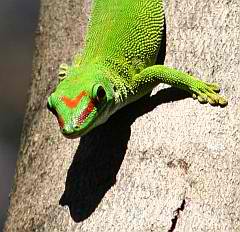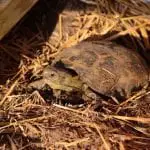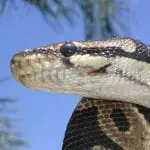Madagascar has been home to some of the world’s most uniquely adapted amphibians and reptiles. Most of them were isolated to some areas of this beautiful island. Despite this, the island of Madagascar suffers from extreme poverty and dreadful economic problems that lead to practices like a burn and slash agriculture, bush meat sale, and unlawful pet trade. All of these things significantly threaten and damage the forests of Madagascar, including the different wild species.
While there are no easy solutions that can help in resolving the economic and ecological complexities in the island, the concerned groups and agencies are aiming to help in raising awareness for the island and the unique animals that can be found living only in this famous island. There are many reptiles and amphibians in the world, but some of them exist only in Madagascar.
This island has a remarkable snake population. Madagascar lacks pythons as they are found in the other parts of Africa. What you will find on this island are boas and rear-fanged snakes. The latter belongs to the group of colubrid snakes that are either non-venomous and venomous. Rear-fanged snakes are not exclusive to Madagascar as they can also be found somewhere else.
Madagascar is home to over 300 species of different kinds of reptiles that over 90% endemic. 36 out of the 64 genera living in the area were not found somewhere else. The reptile fauna of the island includes snakes, tortoises, turtles, crocodiles, and lizards.
The reptiles living in Madagascar are rare and so unique. The boas and iguanid lizards of the island have their nearest relatives originating in South America. The uniqueness of the reptiles found on the island led to a widespread collection for the pet trade of exotic pets. For this page, you will be introduced to some of the wild lizards that commonly exist only in Madagascar.
#1. Day Gecko
Compared to most types of geckos that are nocturnal lizards, the green day geckos are diurnal. Meaning, they stay alive at daytime and will spend the whole night hiding in their preferred natural habitat. The green day geckos are endemic in Madagascar and even in some nearby areas like the Andamans, Comoros, and Seychelles.
These lizards are usually brightly colored. They use body movements and positions for their territorial displays. These animals tend to be aggressive when it comes to their territory during the breeding season.
In many cases, you will see them eating insects. They may eat fruits and flower nectars as well, but insects are always their top preferred food.
#2. Satanic Leaf-Tailed Gecko
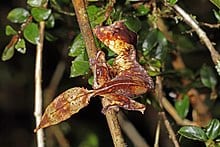
The satanic leaf-tailed gecko, also known as the Uroplatus phantasticus, is a gecko species that are indigenous to Madagascar. The animal was initially described by George Albert Boulenger in 1888. Of all Uroplatus geckos, this one has the smallest body, but the scientists are still debating about this. They argue that its cousin, the Uroplatus ebenaui can be the smallest Uroplatus gecko because its tail is shorter than the tail of satanic leaf-tailed gecko. This species is also known for other names like the phantastic leaf-tailed gecko and the eyelash leaf-tailed gecko.
These lizards depend on the cryptic coloration because they sleep while their heads are positioned downward and flat against the trunks of a tree. They also adjust their coloration all over their bodies based on the environment. Unlike the green day geckos, the satanic leaf-tailed geckos are nocturnal lizards that sleep during the day and will move only when feel disturbed.
They also react to prodding by showing their impressive brightly colored wide mouth and an erected tail. When they wake up at night, these lizards will go out of their hiding spots to hunt and eat insects.
#3. Brookesia Micra

This lizard has been regarded as the world’s smallest chameleon. It was found in 2012 in Nosy Hara, Madagascar. It can grow for up to 29 millimeters. Therefore, this lizard is smaller than your fingertip.
Also called the leaf chameleon or stumped-tailed chameleon, this animal is found in the leaf litters in the rainforests and dry, deciduous forest in Madagascar. The Brookesia Micra feeds on tiny insects.
Likewise, they depend on their cryptic coloration in evading and defeating predators. If something bothers them, these lizards will try to fool the animal or human by playing dead. When it does, the chameleon tries to imitate the fallen leaf on the ground.
#4. The Lotharas Gecko
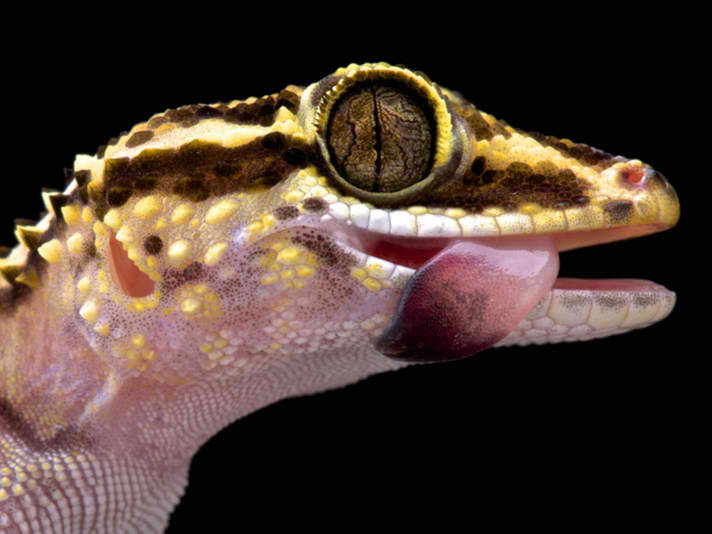
Paroedura lohatsara or the Lotharas Geckos come with cryptic markings that help them to blend perfectly with the fallen leaves where they hide. Most of the reptiles living in Madagascar protect themselves from the predators through camouflage. Just like them, the Lotharas Geckos use their cryptic markings of stripes and brown spots to blend with their surroundings as they hide. However, these geckos need to be more careful in using this ability because most of their predators can also use it against them.
#5. The Parsons Chameleon
The Parsons chameleons are among the world’s biggest chameleons. They became established in some other regions like Florida as non-native species. Above all the chameleon species that can be seen in the different parts of the world, more than 50% of them exist only in Madagascar. Representing the group of chameleons, the Parsons chameleon is among the most famous species.
These lizards are also established in the non-native species such as Florida. They eat both insects and plants and have fun in lingering on the trees, just like what other species of chameleons will do in their everyday lives. These lizards hide inside the isolated humid areas on the island.
The same with other chameleon species, the Parsons Chameleon have fused toes that they use in climbing. They also have prehensile tails, which they can use as their 5th limb whenever they have to. These lizards have become widely available in the American pet trade. They are also listed as near-threatened species in the International Union for Conservation of Nature or IUCN.
#6. Panther Chameleon
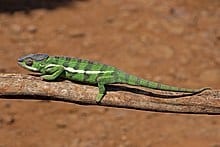
The Panther Chameleons, also known as Furcifer pardalis, is the chameleon species that exist in the northern and eastern portions of Madagascar. They live in the tropical forests within the island. This species has been brought and introduced to Mauritius and Reunion. The panther chameleons become sexually mature at the age of 7 months and beyond.
If they are gravid or with eggs, the female chameleons turn black or dark brown with orange stripes that help them tell the males they are available for mating. The pattern and coloration of the gravid female Panther Chameleons differ based on the color stage of the animal.
Females typically last for 2 to 3 years after they laid eggs in between 5 to 8 clutches. The reason behind their short lifespan is the stress caused by pregnancy. Every clutch can have 10 to 40 eggs, but the number of eggs per clutch may differ depending on the availability of food. The eggs often hatch in 240 days.
#7. Carpet Chameleon
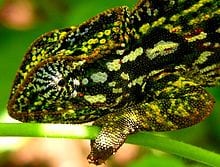
The carpet chameleon, also called Furcifer lateralis, is a chameleon species that is also endemic on the island of Madagascar. This species is sometimes called the white-line chameleon and was described by John Edward Gray in 1831.
These chameleons take as little as 3 months to mature and be ready for breeding. The females may lay 8 to 23 eggs in just one clutch and may have as much as 3 clutches in a year. The eggs should be maintained at a constant temperature of around 75 degrees Fahrenheit or 24 degrees Celsius.
#8. Henkel’s Leaf-Tailed Gecko
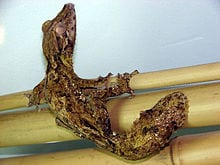
These geckos have the scientific name of Uroplatus henkeli and are also called Henkel’s flat-tailed gecko or frilled leaf-tail gecko. These lizards are endemic to Madagascar, too.
It comes with 2 different morphs. One is the Nosy Be form, while the other is the mainland Madagascar form. Both are easy to distinguish based on their coloration patterns. Sometimes, they are hard to differentiate based on the coloring.
When it comes to length, many of them reach a length of 280 millimeters or 11 inches, including the tail. These geckos are indeed among the biggest individuals in the genus.
#9. Malagasy Giant Chameleon
Also known as the Oustalet’s chameleon or Furcifer oustaleti, this chameleon is a big species that is endemic on the island. The animal was also introduced somewhere near Nairobi in Kenya, although its recent status on the island remains unclear. This animal eats invertebrates like large insects. It uses its long and muscular tongue in catching and eating prey.
#10. Boettger’s Chameleon
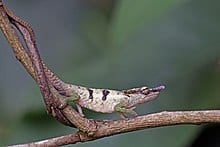
The Boettger’s Chameleon or Blue-Nosed Chameleon is a species that is endemic in the north of Madagascar. It is also common in the forests located in Nosy Be.
Conclusion
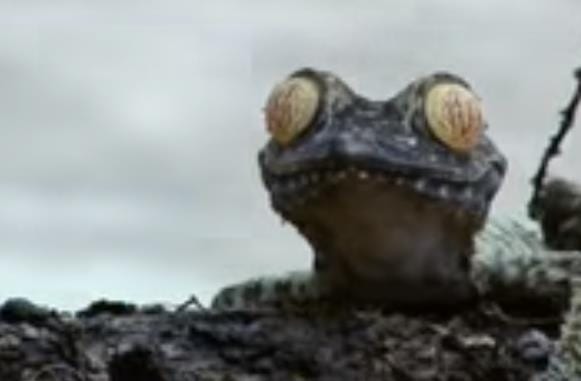
Aside from these chameleons and geckos, Madagascar is also home to more species like the short-horned chameleon, hooded chameleon, Nile Crocodile, Boa manditra, Boa dumerilii, and a lot more. As you can see, Madagascar is truly a wonderful place to explore and find beautiful reptiles that no other place in the world can offer.

